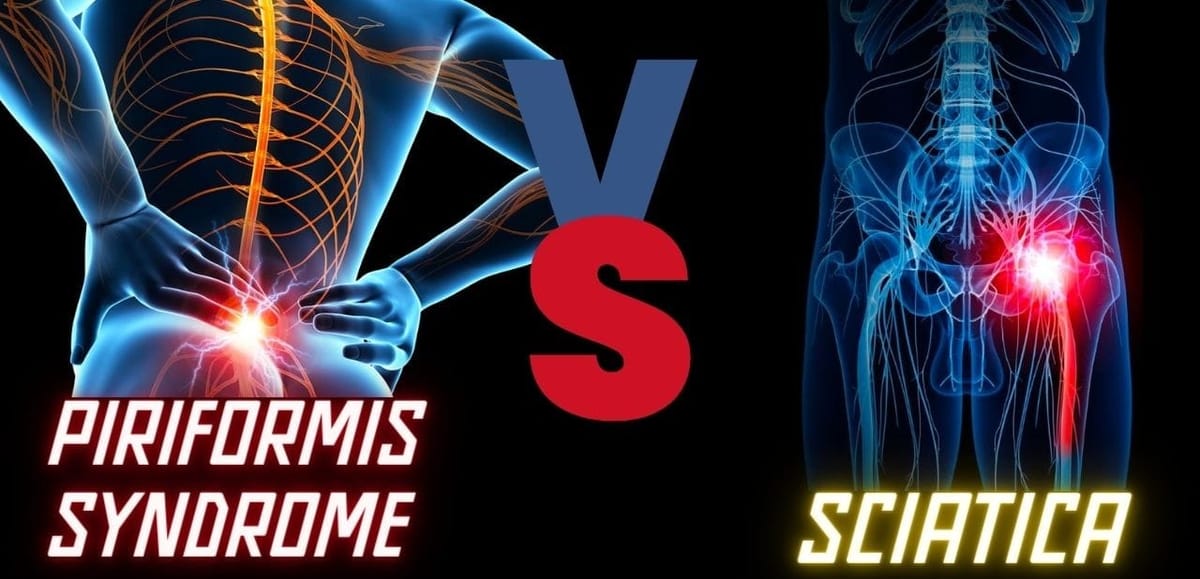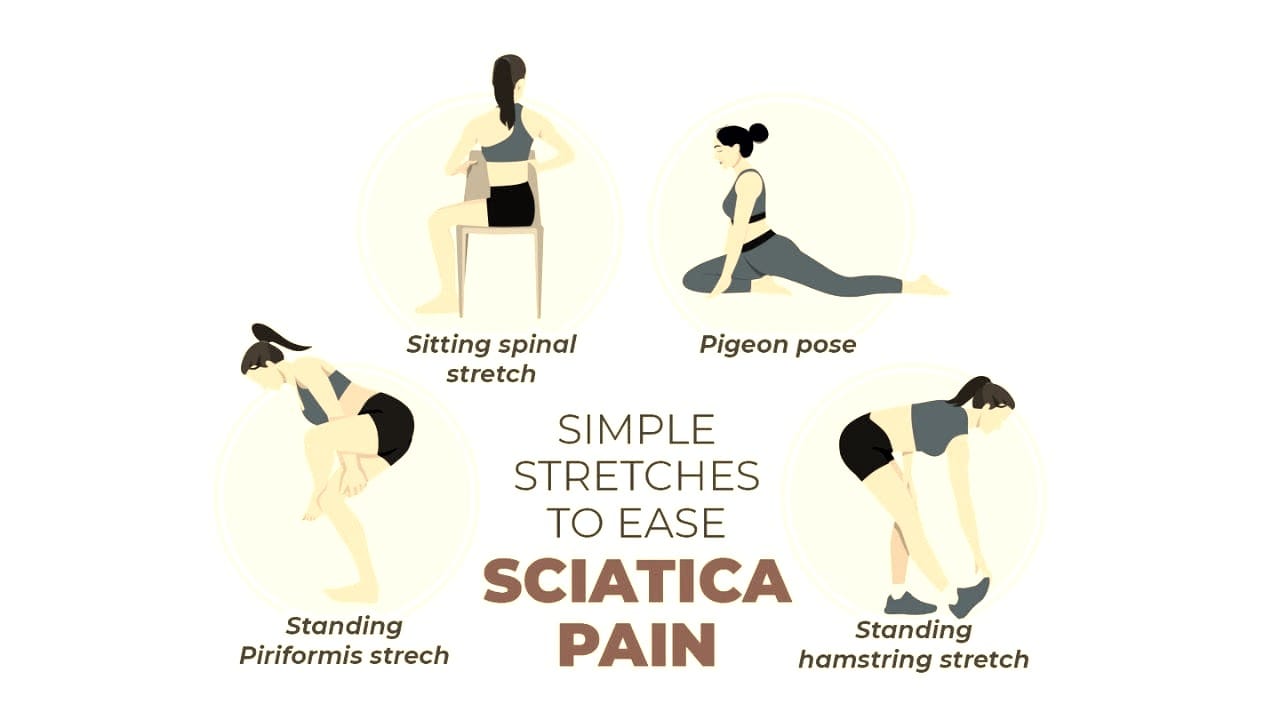Piriformis Syndrome vs Sciatica
Piriformis Syndrome PS and Sciatica may share leg pain, but they differ in root causes. PS involves a tight muscle, while Sciatica stems from nerve compression. Learn more about these common culprits of leg discomfort in our latest blog.

The onset of sciatica can be attributed to various factors such as a herniated disk or spinal stenosis. Typically, its symptoms manifest in the lower back and may radiate down through the buttocks and leg.
On the other hand, Piriformis syndrome presents a distinct scenario, where the focus lies on the compression of the sciatic nerve by the piriformis muscle, specifically within the buttock region.
This article aims to explore and differentiate between Piriformis Syndrome and Sciatica, shedding light on their distinctive features and manifestations.
Piriformis Syndrome
Piriformis Syndrome occurs when the piriformis muscle, located in the buttocks, tightens or spasms, causing pain in the buttocks and sometimes radiating down the leg.
Root Cause
Piriformis Syndrome is caused by the tightening or spasming of the piriformis muscle.
Symptoms of Piriformis Syndrome
- Buttock pain
- Pain that travels down the back of the leg
- Increased pain after prolonged sitting or standing
- Difficulty sitting comfortably
- Tingling or numbness in the buttocks or leg
Sciatica
Sciatica, on the other hand, is not a condition itself but a symptom of an underlying issue, such as a herniated disc, that puts pressure on the sciatic nerve. The sciatic nerve runs from the lower back, through the buttocks, and down each leg. Sciatica can cause pain, numbness, and tingling along this nerve pathway.
Root Cause
Sciatica is a symptom resulting from compression or irritation of the sciatic nerve.
Symptoms of Sciatica
- Lower back pain
- Pain radiating down the leg
- Numbness or tingling in the leg or foot
- Weakness in the leg or foot
- Increased pain when sitting
Comparison
Muscle Involvement
Piriformis Syndrome directly involves the piriformis muscle.
Sciatica involves the sciatic nerve and is often associated with issues like herniated discs.
Location of Pain
Piriformis Syndrome primarily causes pain in the buttocks that may radiate down the leg.
Sciatica causes pain that typically starts in the lower back and travels down the leg.
Sitting and Standing
Piriformis Syndrome pain worsens after prolonged sitting or standing.
Sciatica pain may also increase when sitting, but the severity can vary.
Symptoms Comparison
While both piriformis syndrome and sciatica can produce pain that radiates down the leg, there are subtle differences.
Sciatica pain is typically felt in the lower back and can extend down the back of the leg, possibly even to the foot.
Piriformis syndrome pain is usually confined to the buttock area, although it can also radiate down the leg.
Another key difference is that sciatica pain can be associated with lower back pain, whereas piriformis syndrome is not.
Causes and Risk Factors
The causes of sciatica often include spinal conditions, such as a herniated disc or spinal stenosis, which compress the nerve roots that lead to the sciatic nerve. In contrast, piriformis syndrome is caused by the piriformis muscle itself.
Risk factors for developing piriformis syndrome include a sedentary lifestyle or a job that involves sitting for long periods. For sciatica, risk factors include age-related changes in the spine, obesity, occupation, and prolonged sitting.
Diagnosis: How to Tell Them Apart
Diagnosing the difference between piriformis syndrome and sciatica involves a thorough medical history and physical examination. Imaging tests, such as MRI or CT scans, can help identify sciatica caused by a herniated disc or other spinal issues.
For piriformis syndrome, diagnosis is more about ruling out other causes of sciatica, as there is no definitive test for it. A physical examination that includes various movements and positions can help determine if the piriformis muscle is the source of pain.
Treatment Options
Treatment for sciatica may include medications, physical therapy, and sometimes surgery, depending on the severity of the underlying condition.
For piriformis syndrome, treatment often starts with rest, anti-inflammatory medications, and physical therapy focused on stretching and strengthening the piriformis muscle.

In some cases, injections or surgery may be considered if conservative treatments fail to provide relief.
Physical Therapy and Exercises
Physical therapy is a crucial part of treatment for both conditions. For sciatica, exercises might focus on relieving pressure on the sciatic nerve through stretches and strengthening exercises for the lower back.

In the case of piriformis syndrome, physical therapy will include exercises to stretch the piriformis muscle and reduce the tension on the sciatic nerve, as well as strengthening exercises to improve the muscle's function.
Lifestyle Modifications and Prevention
Making lifestyle changes can help prevent both piriformis syndrome and sciatica.
These may include adopting proper posture, using ergonomic furniture, taking regular breaks from sitting, and engaging in regular exercise that includes stretching and strengthening the back and core muscles.
Maintaining a healthy weight can also reduce the risk of developing these conditions.
When to See a Doctor
It is crucial to consult with a healthcare professional if you are experiencing persistent or severe symptoms related to conditions such as piriformis syndrome or sciatica.
A doctor can provide a thorough evaluation, accurate diagnosis, and personalized treatment plan tailored to your needs.
Early intervention and professional guidance contribute significantly to effective management and improved overall health.
Summary
FAQ Section
Q 1: What is the Difference Between Piriformis Syndrome and Sciatica?
A: Piriformis syndrome and sciatica both involve pain radiating down the leg but have different origins. Sciatica is a symptom caused by compression or irritation of the sciatic nerve, typically by a herniated disc.
Piriformis syndrome, however, results from the piriformis muscle compressing the sciatic nerve, often due to muscle tightness or spasms.
Q 2: What are the Common Symptoms and Causes of Piriformis Syndrome and Sciatica?
A: Both conditions share symptoms like leg pain, numbness, and tingling, but their origins differ. Sciatica often results from spinal issues like herniated discs, while piriformis syndrome is linked to the piriformis muscle compressing the sciatic nerve.
Causes for sciatica are more varied, including spinal stenosis, whereas piriformis syndrome is frequently associated with muscle overuse, injury, or prolonged sitting.
Q 3: How Can I Manage and Treat Piriformis Syndrome and Sciatica?
A: Management strategies for both conditions often involve a combination of rest, physical therapy, and stretching exercises. For sciatica, addressing the underlying spinal issue may be necessary, while piriformis syndrome treatment focuses on relieving muscle tension.
Heat or ice application, anti-inflammatory medications, and in some cases, corticosteroid injections, may be recommended for both conditions. Seeking professional medical advice is crucial for a tailored treatment plan based on the specific diagnosis.
